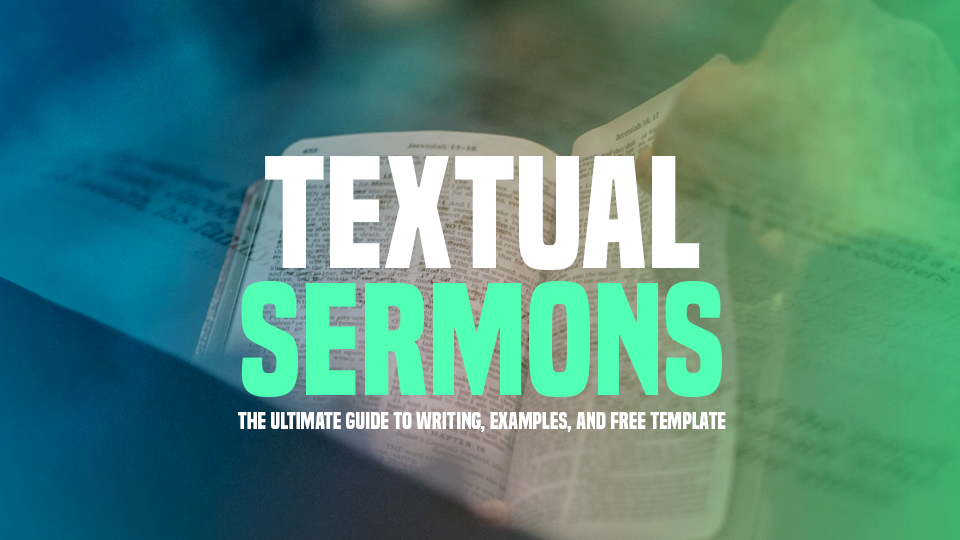Textual sermons are a powerful way to preach God’s Word with clarity and conviction. By focusing on a short scripture passage and drawing your sermon points directly from it, you create a message that’s both rooted in truth and easy to follow. Whether you’re a seasoned pastor or just starting out, this guide will walk you through what textual sermons are, why they matter, and how to craft them—complete with examples and free outlines you can use today. Let’s dive into the world of textual preaching and equip you with everything you need to deliver impactful sermons.
In a previous post, we introduced textual sermons, today we will go a little deeper and give examples of textual sermons.
What Are Textual Sermons?
A textual sermon is a preaching style where the pastor selects a brief scripture passage—often a single verse or a few verses—and builds the entire message around its key ideas. Unlike expository sermons, which explain a longer passage in detail, or topical sermons, which focus on a theme across multiple scriptures, textual sermons keep it concise and text-driven.
For example, a textual sermon on John 3:16 might highlight God’s love, the gift of Jesus, and the promise of eternal life—all drawn directly from that one verse. This approach has deep biblical roots; Jesus Himself often taught this way, unpacking short scriptures like “Man shall not live by bread alone” (Matthew 4:4) with profound insight.
Here’s a quick comparison:
| Sermon Type | Scripture Use | Focus |
|---|---|---|
| Textual | Short passage (1-3 verses) | Points from the text |
| Expository | Longer passage (chapter) | Detailed explanation |
| Topical | Multiple scriptures | Theme or subject |
In a previous article, we explained in further details the difference between different kinds of sermons.
Textual sermons strike a balance: they’re scripture-focused yet not as rigorous as expository sermons.
Why Use Textual Sermons?
Why should you consider textual preaching? Here are some compelling reasons:
- Clarity: A single text keeps your message focused and easy for listeners to grasp.
- Scriptural Fidelity: Sticking to the text ensures your sermon aligns with God’s Word.
- Engagement: A concise, text-driven message holds attention in today’s fast-paced world.
For those new to preaching, textual sermons offer a practical yet powerful way to stay true to the Bible while connecting with your congregation. It is my opinion though, that as one becomes stronger in preaching, expository sermon is the way to go.
How to Write a Textual Sermon (Step-by-Step)
Ready to create your own textual sermon? Follow these steps:
Step 1: Choose a Short Scripture Passage
Pick a verse or short passage with clear, preach-able points. For example, Matthew 6:33—“But seek first the kingdom of God and His righteousness, and all these things will be added to you”—offers a rich foundation.
Step 2: Identify Key Points from the Text
Break the verse into its core ideas. For Matthew 6:33:
- Seek God’s kingdom first.
- Pursue His righteousness.
- Trust God to provide.
Step 3: Develop an Outline
Structure your sermon with an introduction, main points, and conclusion. Here’s a sample outline for Matthew 6:33:
- Introduction: Share a story about misplaced priorities.
- Point 1: Seeking God’s kingdom means putting Him above all else.
- Point 2: Righteousness is living out His will daily.
- Point 3: God promises to meet our needs when we trust Him.
- Conclusion: Challenge listeners to reorder their priorities.
Step 4: Add Illustrations or Applications
Bring the points to life with stories (e.g., a missionary who trusted God’s provision) or practical steps (e.g., “Start your day with prayer”).
This method keeps your sermon simple yet impactful.
Examples of Textual Sermons
Let’s look at two examples of textual sermons from the Getsermons app to inspire you.
- Studying the Bible as Worship: Ephesians 1:3–6, Part 1 by Pastor John Piper
- An Exposition of Psalm 1 (Part 1 of 2) by Alistair
Free Resource for Textual Sermons
Want to get started right away? I found a PDF sermon template you can download and use.
Tips to Enhance Your Textual Preaching
Here are some practical ways to take your textual sermons to the next level:
- Engage with Stories: A relatable illustration (e.g., a parent sacrificing for a child) makes abstract points concrete.
- Practice Delivery: Rehearse to ensure your passion shines through.
- Know Your Audience: Tailor applications to their needs—youth, families, or seniors.
- Avoid Overloading: Stick to 2-3 points; too many dilute impact.
Common Pitfall: Don’t stray from the text. If your points drift into unrelated ideas, it’s no longer a textual sermon—keep it tight!
Conclusion
Textual sermons blend simplicity and depth, making them a timeless tool for preachers. With a short scripture as your foundation, you can craft messages that inspire, teach, and challenge your congregation—all while staying true to God’s Word. Now that you’ve got the steps, examples, and tips, it’s time to try it yourself.
May you remain faithful as you prepare you next sermon. Amen.
